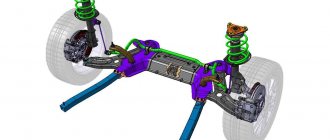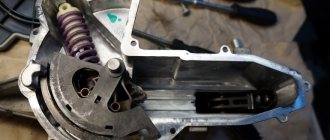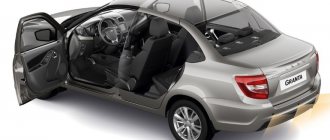The appearance of the new LADA model in 2015, namely the Vesta WTCC, became a real breakthrough in the field of racing cars of the Russian automobile industry as a whole. For the first time, the Lada Vesta WTCC was presented at the Moscow International AutoVaz Auto Show; it is specially designed to compete at the WTCC World Touring Championship, starting in 2015. We were able to see the racing car in action during test runs at the Magny-Cours circuit in France. The bar set by AVTOVAZ at the show was fully justified: Lada Vesta’s aerodynamic and speed indicators are not inferior to foreign competitors. The Constructors' Championship was won at the championship. The triumphant entry onto the podium of the Russian Lada Sport Rosneft driver at the international stage in Argentina is unforgettable, and before that the racing team won prizes in the Russian championship. In their interview, its participants say that the Lada Vesta is a spectacular, improved car in which they competed. Previously, racers rode the 110th model and after it there was the Lada Priora WTCC. The concern in Tolyatti plans to continue the development path of the Lada car in order to develop interest in the Russian brand’s car in the world. The product has the potential to win first places, which is open to racing professionals and amateurs.
What does the racing version of Lada Vesta wtcc look like?
We can safely say that the racing Lada is the best sedan body solution ever designed in the history of the Russian automobile industry, for which we should thank the British automobile designer Steve Mattin. In appearance, the car reminds us of its predecessor, the Lada X-Ray. But what are the fundamental differences between the car and other racing sedans of the brand? 1. Let us note the weight of the model - 1100 kg, while the length, width and wheelbase are 3698/1950/2685 mm. 2. The new aggressive design is different from all other Lada sports cars. It owes a lot to the atypical appearance of the radiator grille and its delicious combination with the oblong cut of the headlights. 3. Powerful and modern equipment of the lightweight body also does not go unnoticed. Each of its elements is strengthened and tightly adapted to the ring track, which adds dynamics when picking up speed. 4. A spoiler is appropriately installed to create acceleration and driving time. 5. The notches on the car’s profile remain unchanged. The car is equipped with 18-inch wheels made of the strongest aluminum alloy. 6. The car has an engine that largely exceeds all the characteristics of previous sedans, which is another achievement of the Russian automobile industry. The complete look of the racing Lada looks very stylish and bright. It’s not scary to call this car the pride of Russian racers.
From “kopek” to “Vesta”: LADA in motorsport
April 10, 2021, 16:57
It is impossible to tell on a few magazine pages about everyone who forged the sports glory of the Volga Automobile Plant. Many volumes would not be enough to describe all the racing models of the plant and those who designed and built them. Therefore, we decided to remember only the very best - the fastest and most deserved, the most successful and bright.
So, meet: Top 10 best sports cars from Tolyatti and Top 10 pilots who competed in AVTOVAZ cars.
VAZ-2101/21011
Who doesn't know "penny"? Motorsport began at VAZ with a production car with a 62-horsepower engine: in the fall of 1970, test drivers Lukyanov, Pistunovich and Frolov persuaded plant director Viktor Polyakov to allocate several cars to the athletes. And by the mid-70s, Togliatti craftsmen managed to increase the power to 150 hp and shed 150 kg from the curb weight. And even in 1979, two “kopecks” with VAZ-21011 engines driven by Nikolai Elizarov and Sergei Vukovich finished top ten in the overall standings at the Akropolis rally, a stage of the World Championship.
Stasys Brundza
A wonderful Lithuanian driver, a talented engineer and an excellent organizer have achieved AvtoVAZ’s highest achievement in the World Rally Championship. In 1976, with co-driver Arvydas Girdauskas, he took 6th place in the overall standings of the Akropolis rally. After which sales of our Ladas in Greece doubled. And the VAZ-2103 prepared by Brundza became the predecessor of a whole series of racing cars Lada VFTS and Lada EVA, built at the Vilnius Automobile Repair Plant.
VAZ-2103
“Treshka” is the dream of an ordinary Soviet person, the most dynamic and elegant of the VAZ models of the early 70s. And thanks to the careful preparation of Stasys Brundza and his mechanics, this car became our pride on the world rally tracks: it was 2103 that set the “eternal” record, taking 6th place at the Akropolis rally in 1976. The one and a half liter engine produced as much as 115 hp. instead of serial 77. And the competitors were Lancia Stratos, Porsche 911, Renault Alpin A110, BMW 2002...
Kastitis Girdauskas
Even if the Lithuanian rally driver had no other achievements to his name, his name would forever go down in the history of AvtoVAZ. After all, it was Kastitis who achieved his first great success driving a Lada. In 1971, he finished second in the overall standings of the Tour of Europe rally, and in 1973 he won this competition. Girdauskas was called a rally driver from God, and was even called the Beethoven of rallying - the ten-time champion of the USSR was a real improviser, a creative person, and with almost no training, on sight, he could show results on special stages that were inaccessible to his teammates on the national team.
Lada Niva Poch
In the 70s, European dealers provided serious assistance in promoting AvtoVAZ products to foreign markets - in Greece, Finland, and Belgium. The biggest motorsport enthusiast was the Frenchman Jean-Jacques Poch. It was with his encouragement that our Niva entered the track of the most difficult Paris-Dakar rally raid. The African odyssey of the Lada Niva Poch lasted seven years, and three times French pilots of Soviet cars climbed to the podium: in 1981 they took third place, and in 1982 and 1983 - second.
Vitaly Bogatyrev
The VAZ test driver became a 7-time champion of the USSR and an 11-time champion of the RSFSR. And from 1978 to 1980, he won silver three times in the Friendship Cup of Socialist Countries. These competitions, in which the strongest masters of circuit racing from Czechoslovakia, East Germany, Poland, Romania, and Hungary participated, could well be called a small European championship. But not only for his amazing versatility - Bogatyrev celebrated success on circuit and cross-country tracks, was among the leaders in winter hippodrome races, twice won the Silver Boat competition in Tolyatti - he was called a legend of VAZ motorsport. In 1974, he opened a motorsport section at the body assembly plant, and by the mid-80s he created the strongest racing team in the country.
VAZ-2108
From 1988 to 1993, there was no discipline in domestic motorsport where the G8 did not achieve success. But in addition to the USSR and Russian championships in circuit racing and rallies, track and cross-country, the VAZ-2108 looked good at the world and European rally championships and even became a bronze medalist at the European Autocross Championship. “Great car to have fun!” — Juan Pablo Montoya, winner of seven Formula 1 Grand Prix, said about him.
Yuri Katsay
A soft, intelligent style and the ability to drive on slippery roads, perfected by winter track and autocross, brought the Togliatti pilot three titles of USSR champion in circuit racing. Moreover, all of them were won while driving the then new VAZ-2105. In 1983, Katsai became second in the Friendship Cup of Socialist Countries, and in 1989, Yuri won this prestigious international trophy for the “body” Union team for the last time.
VAZ-2105 VFTS
For ten years - from 1981 to 1991 - the era of the “five” in the domestic ring and rally continued. And its culmination was the Lada-2105 VFTS prepared in Vilnius. The engine based on the VAZ-2106 developed 160-180 hp, and for seven seasons the Tolyatti cars, modified by Lithuanian engineers, performed brilliantly at the fastest stages of the World Championship, often occupying the entire podium in their class at the “1000 Lakes Rally” and the “Royal English Rally”. auto club."
Jacqui X
This Belgian, of course, became the most famous driver in the history of VAZ: two-time world champion in sports prototype racing, vice-world champion of Formula 1, European champion of Formula 2 and touring car, winner of the 1983 Dakar. But it's not just about titles and victories. It was thanks to Ickx, who in 1987 essentially became a VAZ factory driver in rally raids, that in the late 80s it was possible to build a competitive car to participate in the famous marathon. Jacqui's close connections with . In 1990, the Belgian finished seventh overall and third in the Tunis Rally.
"Lada Niva T3"
In 1994, this almost production-looking Niva took 41st place at the finish of the Paris-Dakar rally raid. Modest, isn't it? However, the result of Alexander Lakeev and his co-driver Valery Kolchugin still remains the highest achievement of a Russian racer driving a Russian car on the famous marathon track. But the original engine produced only 135 hp, allowing it to reach a maximum speed of 170 km/h. Nevertheless, the Lada Niva T3 won the Hungarian Baja twice, and Lakeev finished in the top ten overall in the Paris-Beijing raid in 1995.
Boris Kotello
The multiple national autocross champion from Donetsk became a VAZ test driver and won the Russian championship in 1994. As a member of the national team, he twice became a silver medalist and, finally, set the highest achievement for domestic cross-country athletes - he became a bronze medalist at the individual European Championship. But under the hood of the Samara-Cross there were 180 forces, and the champion Audi had... 550! Nevertheless, Cotello beat her in Spain, becoming the first Russian to win a European championship stage driving a Russian car.
"Lada Samara T3"
Seven seconds to hundreds, 360 forces and 220 km/h! No, this is not a serial V8 - from the VAZ-2108, the mid-engine racing prototype, created specifically for rally raids based on the Porsche 959, only has a windshield, optics and door handles. But the VAZ “rook” proudly flaunted on the carbon fiber body for a reason: in addition to several victories in international rally raids and the title of champion of Spain in this discipline, the Lada Samara T3 took second place in the Paris-Beijing marathon in 1995.
Vitaly Petrov
The path to the top for the first Russian to become a factory Formula 1 driver, and the first to stand on the podium at a World Championship stage, began with cars from Tolyatti. In 2001, the future “Vyborg Rocket” entered the Russian Lada Cup, and the following year became the champion of this series - five victories in five starts! And in 2005, Vitaly participated in two domestic racing series: the Lada Revolution Cup and Formula 1600 - and won both championships. Moreover, while driving the “Revolution”, Petrov won 10 victories in 14 starts. So five years later he found himself in the Renault F1 cockpit.
"Lada Revolution"
It really was a revolution - a project by the team of Vladislav Nezvankin, who today heads the Lada Sport company. When the single-seat racing prototype was shown in the fall of 2003 in Moscow and then in Paris, it seemed like a toy. However, over the next three years, VAZ produced two dozen such cars. A unique sports project for our country has emerged - a racing series using identical and, most importantly, very fast cars. It was the Lada Revolution that became a kind of springboard for our first Formula 1 pilot, Vitaly Petrov - he won the series in 2005. And it served as a prologue to participation in the World Championship.
Robert Huff
By the time the 34-year-old Englishman signed a contract with, he had 23 victories at the world championship stages and a championship title. By the end of his first season behind the wheel of the Lada Grant TS1, he became a favorite of Tolyatti fans. After all, Huff was the first to bring the Russian brand victory at the world championship stage - this happened in October 2014 in Shanghai. And a month later in Macau, Rob repeated his success. “Granta” drove absolutely fantastic today!” – he admired at the top of the pedestal.
"Lada Granta TS1"
The first seasons of the Lada Sport team in the WTCC championship were difficult - neither the Lada-110 nor the Priora in 2008-2009 were able to get closer to the podium. We paid attention to VAZ cars in September 2009, when the Englishman James Thompson twice finished sixth at the stage in Imola, Italy, and the Priora’s lap time was 0.1 second ahead of the BMW. But only when the Granta TS1 with a 320-horsepower turbo engine, prepared by the French company Oreca based on the original cylinder block, entered the ring roads, did the speed of the Tolyatti cars come close to the leaders. The cars from Togliatti were called the “Red Threat” by their rivals. It is curious that the base for the TS1, which was prepared for the world championship races in just 3.5 months, was the Granta Cap, which had already participated in the Russian championship for a year, except that the engine was installed completely different. At first, its power was not enough, so in the 2013 season the Lada pilots failed to rise above 5th place. But after a summer update in 2014, when the engine received an additional 60 horsepower, the ground clearance was reduced from 80 to 60 mm, and 18-inch wheels were installed, the first victories came: Rob Huff won in China and Macau and finished last in the final protocol of the World Championship top ten.
Gabriele Tarquini
Wherever the famous Italian raced! He was a world karting champion, British, European and world touring car champion and spent six seasons in Formula One. But we love him not only for this. In 2021, 54-year-old Gabriele won 2 victories at the stages of the WTCC World Championship driving a Lada Vesta TS1.
"Lada Vesta TS1"
The chassis and body of the 2015 WTCC participant were developed by engineers of the Lada Sport team based on the just debuted production Vesta. And the French from Oreca were responsible for the aerodynamic body kit and engine. They increased the power to 400 hp, and already at the second stage of the championship, Huff brought the team the first points, and at the fifth stage he climbed to the podium, winning second place and beating the then almost invincible Citroens. In 2016, Vesta TS1 went even faster, Gabriele Tarquini won two victories, and already two Lada drivers entered the top ten of the world championship.
Kirill Ladygin
The name of the racing driver from Togliatti has been associated with VAZ motorsport for a decade and a half.
In 2004, Kirill became the first champion of the Lada Revolution series, the first class of sports prototypes in Russian history. Two years later he repeated his success, and in 2011 he won the Russian Cup and the Lada Granta Cup. Since 2009, Ladygin has taught Ladas to drive in the WTCC world championship, and in the last three seasons he has competed in the Russian Touring Car Championship in the Touring class on a Vesta Sport TCR and brought the Lada Sport team prize-winning places in the team and individual competitions: “gold” in 2017, “bronze” in 2018, “silver” in 2019. In addition, Kirill is a seven-time winner of the Race of Champions. Was the article helpful?
- 13
- AVTOVAZ
- motorsport
VK
Gearbox wtcc gearbox
Due to the fact that the Lada Vesta WTCC is intended for racing with sharp extreme turns, where quick gear changes are necessary, the gearbox must, first of all, be short-throw and of high quality. Therefore, the Xtrack transmission, a manufacturer from the UK, was selected and installed for the Lada. This 6-speed gearbox has an external setting and an adjustable “preload” of the inter-axle disc differential, which varies depending on road conditions. The driving wheel is the front one. 3-disc clutch from AP RACING. We must not forget about the dry sump lubrication system, which ensures stable operation of the car, taking into account all sudden changes in its position.
Suspension characteristics
For the Lada Vesta, the suspension was made by AVTOVAZ together with its subsidiary Lada Sport, the MCPHERSON type suspension. Well, now in detail about the suspension itself. The lower link allows you to play with the steering, but repair work is currently underway on it, so it is fixed. Braking mechanisms from AP RACING Vesta, with experience of early use on Grant, have proven themselves reliably, so they were installed on the new car. The shock absorbers are equipped with OHLINS gas and have 3 adjustment parameters. Adjustable stabilizer and power steering.
Braking system
The braking system is dual-circuit and without a booster, but with front and rear brake force adjustment. 4 and 2 piston front and rear brake calipers from AP RACING. Front and rear ventilated brake discs 380 and 260 mm. The braking system is made more than adequately and also has high ratings from racers. Speed characteristics of Lada Vesta WTCC.
With a huge engine performance of 380 horsepower, the engine volume of the Lada Vesta will be 1.6 liters. In the future, AvtoVAZ will improve the model to an engine capacity of 1.8 liters, the trick of this engine is that it can work with two types of fuel. Returning to the topic of the current Vesta, we note that when creating the engine, the engine from the Lada GRANT Sport was used. But modernization did not bypass him either. The car is capable of accelerating to 265-275 km per hour. Engine. The engine, from which 380 horsepower is squeezed, has a displacement of 1.6 liters. Torque - 440 Nm at 4 thousand revolutions per minute. The engine itself was specially manufactured by the French company ORECA. It is more advanced than its predecessors, as it has become lighter and more dynamic. The engine is equipped with a control system from Magneti Marelli. The intake system and the engine shield are treated with thermal insulation material - this is a feature of this engine. As for the lubrication system barrel: it is located to the right of the wing. In general, the technical equipment of the engine is in no way inferior to foreign competitors; the car is capable of leading the team to prizes.
Engine
The engine was manufactured by a French organization specializing in this called ORECA. The 1.6 liter engine has a power of 380 horsepower. This is an improved model of the engine that was installed on the WTCC Grant.
The new engine is more powerful, and it was also built to be lightweight so that the car picks up speed faster. This engine has a torque of 440 Nm at four thousand rpm. Equipped with the proprietary Magneti Marelli control system. A distinctive feature of the engine is that the engine shield and intake are reliably covered with thermal insulation. The lubrication system reservoir is located on the right side of the wing. The new engine will allow our car to fully compete with foreign models and win the WTCC championship.
Wheels
The creation of tires for the Lada Vesta WTCC was undertaken by YOKOHAMA. Since there are no pit stops in WTCC racing, due to the long time required to change wheels, a set of tires is required for each race. There are two races in total, and replacement is carried out if damaged. There are two types of tires used for racing: dry and wet. Before the race, they are prepared - warmed up with heating pads. The size of alloy wheels is 10x18 inches. Made from aluminum alloy. Interesting fact: during tests at the Magny-Cours circuit, the Lada Vesta WTCC performed worse on wet surfaces than the Granta WTCC in ideal conditions.
Body
When creating Vesta, AvtoVAZ paid great attention to body design. Its especially reinforced frame allows riders to feel safe during the race. The mounted units are made of carbon fiber (one of the criteria of the T1C category in which the Lada Sport Rosneft team competes). Numerous reinforcements have been introduced into the design, the presence of which increases downforce during movement. For example, the massive powerful spoiler mentioned above. Vesta’s weight is only 1104 kg, so before the race it is necessary to add ballast to the required 1100 kg. The length of the body is 3698 millimeters. The width is 1950 millimeters, and the wheelbase is 2685 millimeters. The body type is a sedan with a safety cage welded into it. The housing of the LED headlights is made of the same carbon fiber. All in order to lighten the weight of the sports car. Interior equipment. The difference between the interior and all previous models immediately stands out: the air conditioning cools only the rider’s helmet, the console with the power and ignition toggle switches is on the right, there is also the engine start console, fire extinguishing systems, and windshield wiper controls. The OMR seats are made of the same carbon fiber and are adjusted to the rider in advance. For example, before racing on tracks passing through city streets, James Thompson raised the mounts, since in such cases a wide view is necessary. The MOTERS telemetry system is used to control the car. Therefore, the instrument panel shows the driver the necessary information so as not to distract attention from the road too much.
Lada Vesta WTCC characteristics
The domestic team LADA SPORT ROSNEFT takes part in the world competitions among touring cars using the LADA VESTA TC1 (LADA VESTA WTCC). The LADA VESTA WTCC has characteristics superior to the previous racing model LADA GRANT WTCC. That is why the team, and especially the drivers, were happy about the new car.
Engine
Main page: Lada Vesta WTCC engine
The creation of the engine was ordered from the famous French company ORECA in racing circles. It has a power of 380 hp. and volume 1.6 liters. It was also on the LADA GRANT, but now it has been improved.
Aerodynamic body kit
Developed by AVTOVAZ and ORECA, the same company that develops engines. The car has a top speed of 265 to 275 km/h. But it depends on how the body kit elements are configured, what the emphasis is on, speed or downforce when cornering.
Transmission
Manufactured by the famous British manufacturer XTRACK, it is sequential, has 6 gear levels with the ability to be adjusted externally, and an adjustable differential.
In WTCC, mechanics are prohibited from changing gear ratios in the gearbox, but they are allowed to set the “preload” of the cross-axle differential, which changes based on the characteristics of the road: the number of turns, speed, surface.
| Parameter | Meaning |
| checkpoint | XTRACK 6-speed sequential transmission |
| Drive wheels | Front |
| Clutch | 3-disc, AP RACING |
| Interwheel differential | Disc, high friction |
Suspension
Designed and produced by AVTOVAZ, together with its sports division LADA SPORT.
The lower link allows you to play with the steering effect, but now it is rigidly fixed, as repair work is underway:
VESTA received AP RACING brake mechanisms from GRANTS. They were not subject to changes, as they worked well:
| Parameter | Meaning |
| Front and rear suspension | Manufactured by LADA SPORT: MCPHERSON type, OHLINS gas-filling shock absorbers with 3-parameter adjustment, adjustable stabilizer |
| Steering | With hydraulic booster |
| Brake system | Dual-circuit system without amplifier, with adjustable braking force front/rear |
| Front brake caliper | 4-piston AP RACING |
| Front brake discs | Ventilated O 380 mm |
| Rear brake caliper | AP RACING 2-piston |
| Rear brake discs | Ventilated O 280 mm |
Wheels
Currently, tires for all team cars are provided by the Japanese company YOKOHAMA. One race - one set of wheels. There are two races in total. Replacement is only possible if they are damaged. There are no pit stops, as in Formula 1, which is why the duration of the races is short.
There are two types of tires - for dry asphalt and for wet. Tires are warmed up with special heating pads. It seems to me that it would be more spectacular if the racers warmed them up by slipping in one place.
Cast discs, consisting of aluminum alloy, dimension 10×18.
Body
AVTOVAZ developed it independently, together with its racing division LADA SPORT. The body is reinforced with a safety cage, the hinged elements are made of carbon fiber - this is necessary to meet the requirements of the TC1 category, in which the team competes.
LADA VESTA WTCC photo
Weight
The car turned out to be very light - 1104 kg with the driver and without fuel. You have to add ballast to increase the weight to the permissible minimum value of 1100 kg.
Fitting for pneumatic jack. I connected a nitrogen cylinder, sprayed it - and the car bounces on three racks. The same system is used in the WTCC and in the Touring class of the RSKG championship (Russian Circuit Racing Series):
| Parameter | Meaning |
| Body | |
| Body type | Sedan with welded safety cage |
| Number of doors | 4 |
| Overall dimensions, mm, kg | |
| Length | 4628 |
| Width | 1950 |
| Base | 2685 |
| Minimum weight | 1100 (including pilot) |
Salon
The interior of a racing car does not look like a production car. Even the air conditioning here works in a special way: it only cools the rider’s helmet. On the right is a console with toggle switches for turning on the ignition, starting the engine, controlling the windshield wipers and the fire extinguishing system.
The OMP carbon fiber seat is adjusted to the rider in advance. In my presence, the mechanics, at the request of James Thompson, raised the mounts: some routes run along city streets, where better visibility is needed.
Dashboard. The MOTEC telemetry system is used to monitor parameters. The rider is shown only the most necessary information.
Headlights
The LED headlights have a carbon fiber housing to reduce weight. Such headlights began to be installed on LADA GRANT only at the end of the 2014 racing season. At VESTA they are provided initially.
You can get acquainted with the technical characteristics of the civilian version of LADA VESTA on the Lada Vesta characteristics page.











